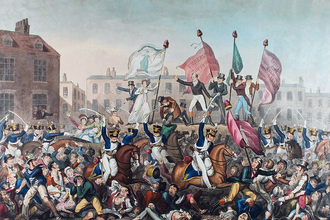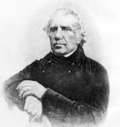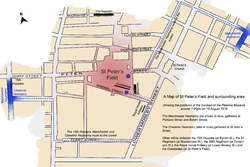Peterloo Massacre
Coordinates: 53°28′41″N 2°14′49″W / 53.478°N 2.247°W
The Peterloo Massacre (or Battle of Peterloo) happened at St Peter's Field, Manchester, England, on 16 August 1819. It was when cavalry charged into a crowd of 60,000 to 80,000 gathered at a meeting to demand the reform of parliamentary representation.
| Peterloo Massacre (Battle of Peterloo) | |||||||
|---|---|---|---|---|---|---|---|
 A painting of the Peterloo Massacre published by Richard Carlile | |||||||
| |||||||
The end of the Napoleonic Wars in 1815 had resulted in a time of famine and chronic unemployment. This was made worse by the introduction of the first of the Corn Laws. By the beginning of 1819 there were poor economic conditions. That, and the limited suffrage (few people had the vote), increased the appeal of political radicalism.
In response, the Manchester Patriotic Union organised a demonstration to be addressed by the radical orator Henry Hunt. The Manchester Patriotic Union was a group agitating for parliamentary reform.
Shortly after the meeting began, local magistrates called on the military authorities to arrest Henry Hunt and several others with him, and to disperse the men. Cavalry charged into the crowd with sabres drawn. In the resulting confusion, 18 people were killed and 400-700 were injured. The massacre was given the name Peterloo in ironic comparison to the Battle of Waterloo, which had taken place four years earlier.
Peterloo Massacre Media
Samuel Bamford led a group from his native Middleton to St Peter's Field. Following his imprisonment for "inciting a riot", Bamford emerged as a prominent voice for radical reform.
A print published on 27 August 1819 depicting Hunt's arrest by the constables
Caricature by George Cruikshank depicting the charge upon the rally
Notice "to the inhabitants of the Hundred of Salford", published by the magistrates the day after the massacre
Peterloo Memorial in front of Manchester Central in 2019
| Wikimedia Commons has media related to Lua error in Module:Commons_link at line 62: attempt to index field 'wikibase' (a nil value).. |





